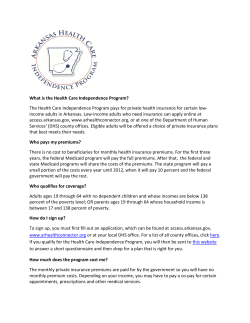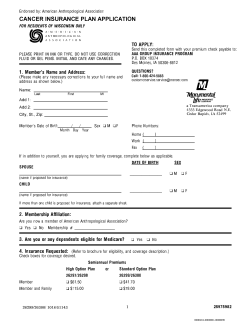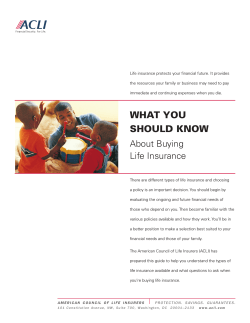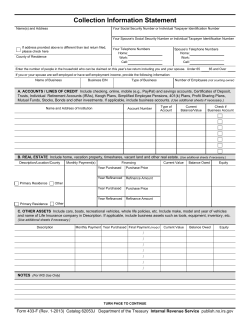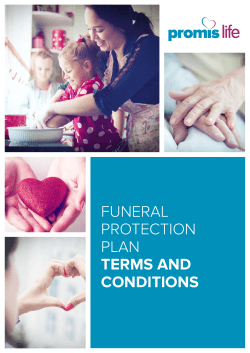
Document 153927
Chances are, you need life insurance L ife insurance is a simple answer to a very difficult question: How will my family manage financially when I die? It’s a subject no one really wants to think about. But if someone depends on you financially, it’s one you cannot avoid. Don’t have life insurance? You’re not alone. There are many types of life insurance, but for all of them the bottom line is the same: They pay cash to your family after you die, allowing loved ones to remain financially secure. Life insurance payments can be used to cover daily living expenses, mortgage payments, outstanding loans, college tuition and other essential expenses. And, importantly, the death-benefit proceeds of a life insurance policy are almost never subject to federal income taxes. 1 93% of Americans say that life insurance is something most people need If you’ve worked hard to establish a solid financial framework for your family—investments, home equity, a savings plan, retirement accounts—life insurance is the foundation upon which it all rests. It can guard against the need for your loved ones to make drastic changes to future plans when you die. Certain types of life insurance even have a built-in cash-accumulation feature that can help you reach savings goals. Most Americans need life insurance, and many who already have it may need to update their coverage. This guide will inform you of your options and help you put together an insurance program that’s right for you. 2 41% own an individually purchased policy 1 2 LIFE Foundation and Kelton Research, 2008 LIMRA International, Trends in Life Insurance Ownership, 2005 A Mother’s Wish W hen Jackie Blanchard’s husband died at a young age, with only enough life insurance to pay for his funeral, Jackie vowed that her young daughters, Ebony and Shanna, would be financially secure if anything were to happen to her. To keep this promise, Jackie bought the best life insurance she could afford. Two years after purchasing her policy, Jackie was diagnosed with terminal lung cancer. She invoked a provision in her policy that allowed for an early payout to a terminally ill policyholder, and was able to withdraw 75 percent of the proceeds to finance a home and a car for her daughters and parents, and to prepay her funeral. She also put money away for her daughters’ college education. Jackie died at age 38, but her dreams for the girls are very much alive. Ebony recently graduated with honors from college, and Shanna, a senior in high school, lives with her grandparents in the home her mother purchased. “Jackie wanted the girls to have the best education and the same lifestyle after she was gone,” says Jackie’s mom, Verodia. “That’s why she chose insurance, to help them along the way.” Shanna and Ebony Blanchard The Life and Health Insurance Foundation for Education is a nonprofit organization dedicated to helping consumers make smart insurance decisions to safeguard their families’ financial futures. © 2009 LIFE. All rights reserved. Insuring the times of your life I f someone depends on you financially, you probably need life insurance. Here are some examples of specific life stages or life events that might trigger the need for life insurance. services that would be expensive to replace, such as childcare, transportation and household chores. And what about single parents? They need life insurance more than anyone because their children rely on them for everything. that your family would be able to maintain its new and improved lifestyle if something were to happen to you. Married or Getting Married Many families depend on two incomes to make ends meet. If you died suddenly, would your spouse have enough money to cover your funeral costs, credit card balances, outstanding loans and daily living expenses? A Parent or About to Become One Raising a child is one of the most rewarding things a person can do in life. But it’s also one of the most expensive. If you died tomorrow, would your spouse have the wherewithal to provide your children with the opportunities you always dreamed they’d have? From diapers to diplomas, would there be enough income to pay for daycare, a college education and everything in between? Even parents who don’t work outside the home need life insurance because they provide Retired or Planning for Retirement A Homeowner If you’re like most people, your home is your most significant financial asset. Life insurance can be used to pay down or retire the mortgage, sparing your family from moving to a less expensive place to live. Plus, it can provide the funds needed to help family members maintain the lifestyle to which they’re accustomed. Changing Jobs If you’ve recently been promoted or changed jobs, it’s a good time to reevaluate your life insurance coverage. Why? You may not realize it, but when your income rises, your spending tends to rise, too. Updating your life insurance coverage can help ensure If your children are on their own and your mortgage is paid off, you might feel your need for life insurance has passed. But if you died today, your spouse could outlive you by 10, 20 or 30 years. Would your spouse have to make drastic lifestyle adjustments to make ends meet? Adequate life insurance coverage can help widows and widowers avoid financial struggles in retirement. Single Most single people don’t have a pressing need for life insurance because no one depends on them financially. But there are exceptions. If you’re providing financial support for aging parents or siblings, or if you’re carrying significant debt you wouldn’t want passed on to family members, you should consider life insurance. 3 How much do you need? T he most important part of buying life insurance is determining how much you need. Since everyone’s financial circumstances and goals are different, there is no rule of thumb to tell you how much to buy. But do you really need $250,000, $500,000, $1 million or more? Sounds like a lot of money, but imagine if one of those amounts had to pay for a funeral, retire credit card balances and other debts, and support your loved ones for many years to come. Would it be enough? How would you know? To start, estimate what your family members would need after you’re gone to meet immediate, ongoing, and future financial obligations (see right for examples of each). Then, add up the resources your surviving family members could draw on to support themselves. These would include things like a spouse’s income, accumulated savings, life insurance you may already own, etc. The difference between the two is your need for additional life insurance (see below). This mathematical equation may seem simple enough, but coming up with all the inputs can get tricky. Plus, you’ll need to factor in the effects of inflation and assumptions about how much your investments will earn over the long run. How Much is Enough? The average adult American only has coverage equal to four times his or her annual income.1 When you consider all the things that life insurance proceeds need to fund and how long the money will be needed, you begin to realize that your true need for coverage is often 10 or 15 times your gross annual income, sometimes more. Insurance Proceeds Can Fund Many Types of Expenses Immediate Expenses ✔ Funeral costs ✔ Uncovered medical expenses ✔ Mortgage ✔ Car loans ✔ Credit card debt ✔ Taxes ✔ Estate settlement costs Fortunately, there are plenty of resources you can turn to for assistance. A first step would be to visit an online Life Insurance Needs Calculator like the one offered by the nonprofit LIFE Foundation (www.lifehappens.org/lifecalculator). Just remember that online calculators are no substitute for the advice you’ll get by meeting with a qualified insurance professional, who can conduct a thorough analysis of your needs, and then help you determine the right amount and type of life insurance to protect the ones you love. Ongoing Expenses ✔ Food ✔ Housing ✔ Utilities ✔ Transportation ✔ Health care ✔ Clothing ✔ Insurance Calculating Your Life Insurance Needs Current and future financial obligations 4 – Spouse’s earnings, savings, investments and life insurance you already own = Life Insurance Needed Future Expenses ✔ College ✔ Retirement 1 LIMRA International, Trends in Life Insurance Ownership, 2005 Life insurance needs worksheet T his worksheet can help you get a general sense of how much life insurance you need to protect your loved ones, assuming that you died today. Before buying any insurance products, you should consult with a qualified insurance professional for a more thorough analysis of your needs. Table A Years Income Needed 10 15 20 25 30 35 40 Factor 8.8 12.4 15.4 18.1 20.4 22.4 24.1 Income 1. Total annual income your family would need if you died today What your family needs, before taxes, to maintain its current standard of living (Typically between 60% - 75% of total income) 2. Annual income your family would receive from other sources For example, spouse’s earnings or a fixed pension.1 (Do not include income earned on your assets, as it is addressed later in the calculation) 3. Income to be replaced Subtract line 2 from line 1 4. Capital needed for income Multiply line 3 by appropriate factor in Table A. Factor ______. $____________ $____________ $____________ $____________ Expenses Table B Years Before College 5 10 15 20 Factor .95 .91 .86 .82 Note: These tables help you determine Net Present Value (NPV), the amount of capital required today to satisfy future income or college cost needs, given an assumed investment return of 6%, inflation of 3% for living costs and 5% for college costs. Prefer to Use an Online Calculator? Visit the nonprofit LIFE Foundation’s Life Insurance Needs Calculator at www.lifehappens. org/lifecalculator 5. Funeral and other final expenses Typically the greater of $15,000 or 4% of your estate 6. Mortgage and other outstanding debts Include mortgage balance, credit card balance, car loans, etc. 7. Capital needed for college (2007-2008 average 4-year cost: Private, $146,210; Public, $61,4992) $____________ $____________ Estimated Appropriate Factor NPV 4-Year Cost in Table B Child 1 ______________________ X ____________ = _____________ Child 2 ______________________ X ____________ = _____________ + $____________ Child 3 ______________________ X ____________ = _____________ 8. Total capital required Add items 4, 5, 6 and 7 $____________ Assets 9. Savings and investments Bank accounts, money market accounts, CDs, stocks, bonds, mutual funds, annuities, etc. 10. Retirement savings IRAs, 401(k)s, SEP plans, SIMPLE IRA plans, Keoghs, pension and profit sharing plans3 11. Present amount of life insurance Including group insurance as well as insurance purchased on your own 12. Total income producing assets Add lines 9, 10 and 11 13. Life insurance needed Subtract line 12 from line 8 1 2 3 $____________ $____________ $____________ $____________ $____________ Social Security benefits, which may be available, have not been factored into this calculation. Trends in College Pricing, 2007, The College Board. Costs reflect total charges, which include tuition, fees, room and board. Distributions from most retirement savings plans are subject to ordinary income tax rates. 5 What kind should you buy? T he most basic feature of a life insurance policy is the death benefit: the lump-sum payment your beneficiaries would receive if you were to die. It’s the core reason to own life insurance—but not the only one. Some types of life insurance offer other features that can play an important role in your financial strategy, such as the ability to accumulate cash value that grows over time. Term Insurance Term life insurance provides protection for a specific period of time—the “term”—and is designed for temporary circumstances. It makes the most sense when your need for coverage will disappear at some point, such as when your children graduate from college or when a debt is paid off. The most common term policies provide coverage for 20 years, but they can run the gamut from one-year policies to terms of 30 years or even longer. Typically, term insurance offers the greatest amount of coverage for the lowest initial premium and is a good choice for young families on a tight budget. Permanent Insurance Permanent insurance offers lifelong protection, and you can accumulate cash value on a tax-deferred basis. This cash account can be used for a variety of purposes, from helping you out of a tight financial spot, to providing funds to take advantage of an opportunity, to supplementing your retirement income. The downside? Initial premiums are considerably higher than what you would pay for a term policy with the same face amount. Permanent insurance falls into four main categories. Whole life is the simplest and most common option. What Premiums remain the same for life, Length of and the death coverage benefit and rate of return on your Premiums cash value are guaranteed. With variable life, you can seek potentially Cash value better returns by allocating your fixed premiums Key advantage among investment sub-accounts, typically comprised of stocks and bonds. Universal life offers the flexibility of varying the amount of your premium payments. It also offers the certainty of a guaranteed minimum death benefit as long as your premiums are sufficient to sustain it. If you do not maintain those minimum premiums, your death benefit can be reduced. Variable universal life premium payments are also adjustable, subject to the minimum needed to keep the policy in force, and you can allocate them among investment sub-accounts that offer varying degrees of risk and reward. Kind is Right for Me? Term Permanent A specified term, typically 10, 20 or 30 years Until age 100 or later, as long as premiums are paid Considerably lower than permanent insurance, when initially purchased Initially higher than term premiums, but often level for life None Accumulates over time on a tax-deferred basis Typically offers the highest death benefit for the lowest cost Offers lifelong protection and taxdeferred savings Features Unique to Permanent Insurance ACCESS TO CASH A policy’s cash value can be surrendered, in total or in part, for cash that can be put toward important uses like a child’s education, a business opportunity or supplemental retirement income. Also, you can borrow from your insurer at relatively low interest rates and use the cash value as collateral. The loan is not dependent on credit checks or other restrictions like loans from most financial institutions. Keep in mind that borrowing or withdrawing funds from your policy will reduce its cash value and death benefit if not repaid. 6 FLEXIBILITY If you need to stop paying premiums, the cash value can keep your insurance protection in force for a period of time. TAX ADVANTAGES Cash value accumulates on a taxdeferred basis, similar to assets in most retirement and college savings plans. Death benefits paid to the beneficiary generally are not subject to federal income tax. GUARANTEED COVERAGE As long as you don’t allow your policy to lapse, you’ll have the coverage for life and won’t need to worry about being unable to afford coverage if your health deteriorates. STABLE PREMIUMS With many types of permanent insurance, premiums will remain constant or stable over your lifetime. With term insurance, premiums often increase as you age. 3 ways to buy life insurance If you don’t have life insurance or need more coverage than you already have, there are three main ways to obtain additional coverage: 1 Through an Insurance Professional Most people need help conducting the detailed financial assessment needed to determine how much and what kind of insurance to buy. That’s why they usually turn to a qualified insurance professional. To find one that’s right for you, ask for recommendations from friends, relatives or a trusted advisor, such as a lawyer or accountant. Before agreeing to work with an agent, interview at least two to establish a basis for comparison. Ask them about their education, training, professional designations, and if they are a member of a professional association, such as the National Association of Insurance and Financial Advisors, which has a stringent code of ethics to which its members agree to adhere. 2 At Work Many employers, especially larger ones, offer life insurance as part of their benefits package—usually a term policy equal to one or two times your annual salary—at no cost to you. This is called group insurance, a nice benefit to have, but it’s typically not enough to meet most people’s needs. If you need more coverage than your employer’s “basic” benefit, talk to your benefits manager at work. Many companies give their employees the option to purchase additional coverage through their employer’s group plan. Often, you can purchase limited amounts of extra coverage without having to answer questions about your health. If you want to significantly increase your coverage, you may have to answer health questions in order to qualify. If your employer doesn’t offer a group life insurance benefit, you still might be able to get coverage through work. Some companies give their employees the option to buy life insurance on a voluntary, employee-paid basis. While you pay the full cost of the benefits under a voluntary arrangement, there are several advantages to buying insurance this way. Voluntary plans help workers get coverage more easily than if they were to purchase an individual policy on their own outside of the workplace. Plus, the premium can be automatically deducted from your paycheck, and can be less expensive because of efficiencies in application and billing procedures. 3 Direct Purchasing You can purchase coverage via the Internet, over the phone or by mail. The better services provide qualified insurance professionals to guide you through the process, and offer competitive quotes from multiple life insurance companies for term life insurance. Based on your specific health situation, finding the right company is important in getting the best price available. Keeping His Spirit Alive A s a young insurance agent, Mark Wandall didn’t need to be convinced to buy life insurance. But even he would have been amazed at all that the insurance has meant for his wife, Melissa, and for many others he never met. Mark was just 30 when he was killed in a car accident only a mile from his Bradenton, Fla., home when another driver ran a red light. He died less than a week after celebrating his first wedding anniversary and just 19 days before the birth of his daughter, Madison Grace. The life insurance has allowed Melissa to remain in their home, be a fulltime mom and put money into a college fund for Madison. In addition, she formed the Mark Wandall Foundation to raise money for local causes, and is spearheading the push for a state law to stiffen penalties for running a red light. Life insurance has given Melissa the opportunity to keep Mark’s spirit alive for her daughter and her community. Melissa Wandall with daughter Madison Grace 7 1655 North Fort Myer Drive, Suite 610 Arlington, VA 22209 8
© Copyright 2025



